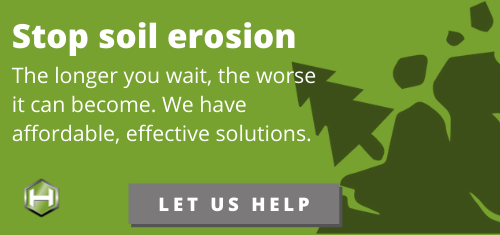What is Soil Erosion?
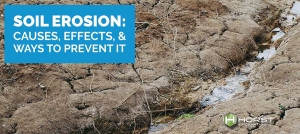
Soil erosion is the natural process in which the top layer of soil is stripped away. While erosion can happen anywhere, it’s especially a challenge on sloping land where water runoff is the most intense.
Left unchecked, erosion can strip the topsoil from your property and compact the earth that remains. Soil that’s compacted in this manner often can’t absorb as much water, increasing the risk of floods and more severe erosion.
What Causes Soil Erosion?
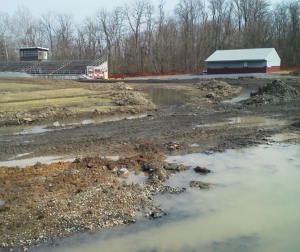 Soil erosion is typically caused by two factors: water and wind.
Soil erosion is typically caused by two factors: water and wind.
Water erosion will have a greater effect on soil the longer and more intensely it rains. Rainstorms that dump a large amount of water into a specific area in a short amount of time, like a thunderstorm, are more likely to cause severe erosion. Lighter but longer in durations rainstorm will contribute to erosion more gradually.
Erosion by wind happens when heavy gusts or winds blow loose particulates which redistribute the soil. Wind erosion is much less of a challenge in our area of the country, as it’s more prone in windy areas with very fine soils like sand.
What Are the Effects of Soil Erosion?
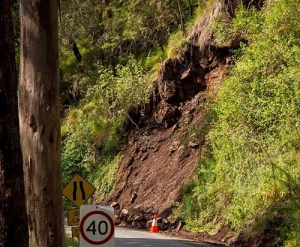 Rushing stormwater runoff sweeps loose soil into streams and rivers, adding particulates and clogging the waterways. This can harm aquatic life and can lead to water pollution. Because waterways are interconnected, eroded soil can travel from your small local stream to the nearby river and eventually to bays and oceans.
Rushing stormwater runoff sweeps loose soil into streams and rivers, adding particulates and clogging the waterways. This can harm aquatic life and can lead to water pollution. Because waterways are interconnected, eroded soil can travel from your small local stream to the nearby river and eventually to bays and oceans.
Soil erosion can also wreak havoc on your property and surrounding infrastructure as well. It can strip the fertile topsoil from your land and increase the likelihood of flooding. Left unchecked, rapid and severe erosion can lead to shifting land and landslides.
How to Prevent Soil Erosion
Soil erosion is a natural process that happens to land all over the world. However, there are things we can do to lessen its impact.
Vegetation
Planting grasses, shrubs, and trees is a great way to naturally curb soil erosion. The roots from these plants help to hold the topsoil in place against subsurface water flow by acting as a solid barrier against flowing water. Additionally, the vegetation breaks the force of raindrops falling from the sky and slows surface runoff.
Groundcovers, like ivies and clovers, are a popular option for reducing soil erosion. They grow quickly and their strong, spreading roots make it difficult for the soil in which they’re planted to wash or blow away. Similarly, grass roots grow quickly and reach deep into the soil.
Shrubs and trees are also great options. While these may take a little longer to grow, their strong roots will keep soil in place deep below the surface.
In addition to keeping soil in place, vegetation can also act as a filter, keeping pollutants and sediment out of waterways.
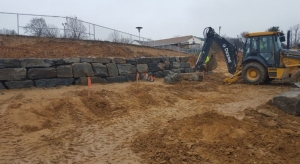
Retaining walls break up the steep slope, slowing soil erosion caused by storm runoff.
Strategic Grading
One way to decrease erosion is to flatten the sloping land that facilitates it. By cutting and restructuring the land, you can stabilize the ground by eliminating existing slopes. Through leveling off slopes with the help of retaining walls, you can help keep soil in place.
Stormwater Management
If rain runoff and stormwater is the major cause of erosion on your property, you’ll want to develop a strategy for diverting it to proper channels.
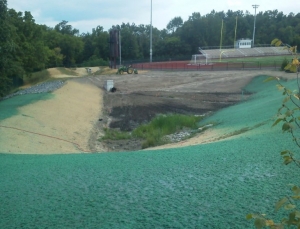
Seeding and vegetation lining a newly created retention basin.
Rainwater chutes and runoff pipes can be created and installed to alter the flow of runoff and divert it from areas prone to erosion.
From there, these pipes and chutes can direct the water to a particular area that can properly manage the runoff, like a retention basin or a rain garden. These will hold the rainwater and filter out the particulates.
Riprap & Gabions
Riprap is rock and rubble strategically placed to act as a barrier from eroding sources. This approach is mostly used on land near streams, rivers, and shores—areas with constant exposure to flowing water and places that experience concentrated stormwater runoff.
Should the slope of these areas be too great for the rocks and rubble to maintain stability, they’ll be placed in wire cages, which will hold the riprap in place. These are known as gabions.
Erosion Fences
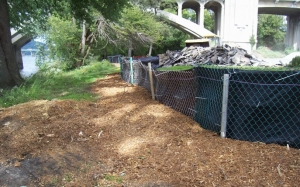
A temporary erosion fence and natural fibers provide erosion control on a river-side construction site. These precautions filter out dirt and particulates from rainwater runoff entering the river.
Erosion fences are used to keep ground particulates roughly in one area.
Some fences are comprised of wooden stakes held together by wiring, like those you’d expect to see on a beach. They can also be comprised of plastic or mesh material held upright with poles.
While fences alone won’t entirely prevent erosion in this area, as the particulates will still move around against the fence, it does help keep the soil in a specific area. This can be especially helpful to keep particulates from blowing out onto roads or into buildings, or stormwater runoff carrying pollutants into waterways.
Erosion fences are also used on construction sites to keep dirt and gravel from blowing around or washing downhill and into the waterways. These are temporary and will be removed once more permanent erosion control solutions are installed and the loose dirt is covered with vegetation.
Silt Socks
Another often-used method for keeping erosion under control on a construction site is silt socks. These are created as compost and mulch are blown into a mesh tube. Wooden spikes are pounded into the sock to help keep it in place.
Silt socks come in a variety of sizes and lengths and can filter water runoff. Once the project is completed, the mulch and compostable material inside can be worked into the ground, making for a quick cleanup.
Some jobsites will utilize just erosion fences, just silt socks, or a combination of both, depending on the local conservation district’s guidelines and the site’s layout.
Blankets
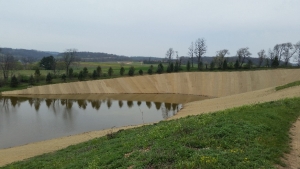
Erosion control blankets cover a downslope leading into a pond.
Erosion control blankets can be made from a variety of materials including coconut fibers, straw, and man-made fabrics.
They’ll be placed on top of the soil and are then typically buried at the top to keep them in place. These blankets will help keep the soil in place by absorbing and slowing down runoff.
Fiber Rolls
Fiber rolls consist of long tubs or rolls that are strategically placed on a downslope. The steeper the slope the more closely the rolls will need to be placed to keep ground particulates in place.
Fiber rolls are typically a temporary solution to erosion control and are primarily used on construction sites until dirt mounds are dispersed and other more permanent erosion control methods are employed.
Solving Your Soil Erosion Issues
Every site has different characteristics that impact soil erosion. Because of this, every site will need a unique soil erosion solution to stabilize its ground and prevent damage from rains, winds, and runoff.
At Horst Excavating, we offer design, installation, and maintenance for standard and specialty erosion control systems, as well as water erosion and sedimentation compliance. We’ll analyze your site and create a solution to your erosion control issues, whether it’s for a temporary project or a long-term application.
With each rain shower or windy day, your soil could be eroding. Put an end to erosion’s damaging and dangerous effects. Call us or send a message for your free consultation today.
Posted April 29, 2021

